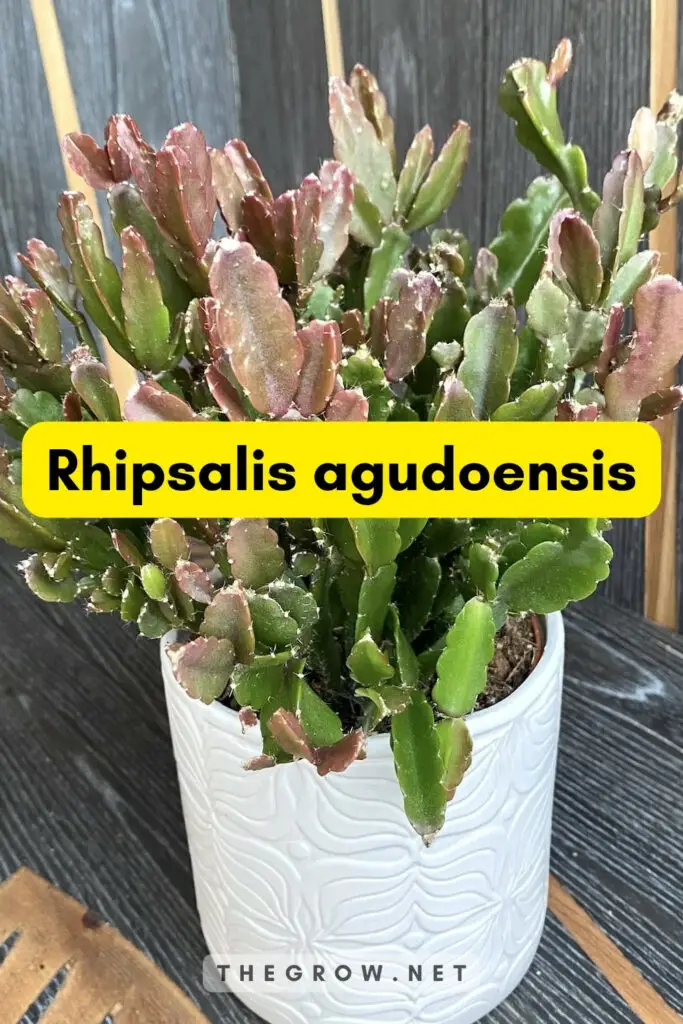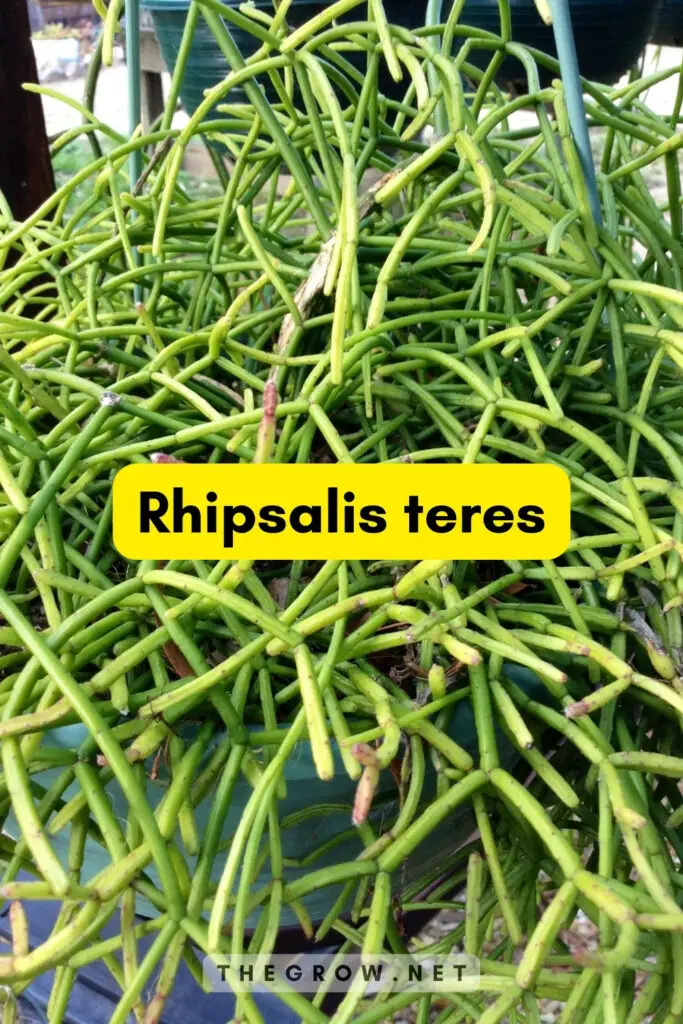In This Article Show
If you’re looking for a plant that is both versatile and beautiful, you’ll want to learn more about the Rhipsalis varieties.
Rhapsalis is a common choice for beginners because it’s easy to grow and care for. No matter what type of Rhipsalis you choose to grow, they make an excellent addition to any indoor or outdoor space. With their unique hanging stems and small flowers, these cacti add a touch of charm wherever they are placed.
With so many types, ranging from the common to the rare, this gorgeous and hardy cactus family can bring unique value and character to your garden or balcony.
In this article, discover 25 of the most common and rare varieties of Rhipsalis in 2024!
Rhipsalis Plant Overview
Rhipsalis is a tropical cactus species native to Central and South America, known for its thin, elongated, and green leaves. It is also known as the Mistletoe cactus because it resembles the mistletoe plant.
It is relatively easy to care for, and it’s often used as a houseplant or in outdoor container gardens. It prefers warm and humid environments and it’s important to keep the soil consistently moist but not waterlogged.
Get Gardening For Beginners
Our new EBOOK shows newcomers and green thumbs alike a step by step guide to growing the garden of their dreams.
| Common name | Rhipsalis, Mistletoe Cactus |
|---|---|
| Scientific name | Rhipsalis spp. |
| Family | Cactaceae |
| Origin | Central and South America |
| Height | Can grow up to 10 ft tall |
| Leaves | Tropical, prefers a warm and humid environment |
| Flowers | Small, white or green, and insignificant |
| Fruit | Small berries |
| Season | Spring to fall |
| Climate | Tropical, prefers warm and humid environment |
| Soil | Well-drained and nutrient-rich, pH 6.0-7.0 |
| Light | Bright, indirect light, can tolerate some shade |
| Watering | Keep soil consistently moist, but not waterlogged |
| Propagation | Stem cuttings or seeds. |
Keep in mind that the plant is not tolerant to frost and it’s best to keep it indoors or in a greenhouse in cold temperatures.
25 Common And Rare Types Of Rhipsalis
We have listed below 25 common and rare types of Rhipsalis plants.
1. Rhipsalis bacciferas

Rhipsalis baccifera is a Rhipsalis variety that is native to Central America and the West Indies. It is a cactus-like plant that can grow up to 15 feet tall. The stem of the plant is slender and has many small, sharp spines. The flowers are white or pink and bloom in the late spring or early summer. The fruit of the plant is red and berry-like.
This plant makes an interesting addition to any container garden or landscape. It is known to be fairly easy to care for and can thrive in bright, indirect light, adequate humidity, and low temperatures. Overwatering should be avoided because it can cause root rot.
2. Rhipsalis cereuscula

Rhipsalis cereuscula, or “flowering cactus,” is a popular type of Rhipsalis. It is known for its small, white flowers that bloom in the spring and summer. This cactus is native to Brazil, but it can be found in other parts of South America as well. Rhipsalis cereuscula is a relatively easy plant to care for and can be grown both indoors and outdoors.
This type of cactus prefers bright but indirect sunlight and should not be exposed to direct sunlight. It does well in normal household temperatures, and its soil should be kept slightly moist for best growth.
It also requires occasional fertilization, usually during the summer months. Rhipsalis cereuscula is a particularly hardy species of cactus, so it’s very forgiving if the conditions are not ideal.
Get Gardening For Beginners
Our new EBOOK shows newcomers and green thumbs alike a step by step guide to growing the garden of their dreams.
3. Rhipsalis gaertneri

Rhipsalis gaertneri, also known as the Easter cactus, is a beautiful and unique Rhipsalis variety. It gets its name from the way its flowers bloom around Eastertime. This cactus is native to Brazil and can be found in the rainforests there.
The flowers of this cactus are white or pink and have a bell-like shape. The stems of this cactus are green or brown and can grow up to 18 inches long.
4. Rhipsalis pilocarpa

Rhipsalis pilocarpa is a species of Rhipsalis native to the Atlantic Forest ecoregion of southeastern Brazil. The plant typically grows to 30–60 centimeters (12–24 in) in height. The stems are slender and erect, with small oval leaves arranged spirally along them.
The flowers are white or pale pink and appear at the ends of the stems. The fruit is a spherical berry, green when immature, and ripens to red or purple. In its natural habitat, Rhipsalis pilocarpa grows as an epiphyte on trees in humid forest environments.
It is adapted to receiving little direct sunlight and prefers shady conditions. It is also tolerant of high humidity and can tolerate brief periods of drought.
5. Rhipsalis burchellii

Rhipsalis burchellii is a rare variety of Rhipsalis that is native to Brazil. It is a low-growing, trailing plant that can reach up to 2 feet in length. The stems are thin and delicate, with small, oval-shaped leaves. The flowers are small, white, and have four petals.
This is an ideal plant for hanging baskets or window sills. They prefer a bright, sunny location and need to be kept moist but not soggy. It is a relatively easy plant to grow and can be propagated by stem cuttings.
6. Rhipsalis elliptica

Rhipsalis elliptica is a type of cactus that is native to Brazil. It is a member of the family Cactaceae and the genus Rhipsalis. The plant grows as an epiphyte on trees or rocks in humid forests. It has green, elliptical stems that are up to 50 cm long and 2.5 cm wide. The stems are covered with small, brown spines. In the spring, the plant produces small white flowers.
7. Rhipsalis pachyptera

Rhipsalis pachyptera is a Rhipsalis variety that is native to Brazil. It is a stemless or short-stemmed epiphytic cactus that grows up to 30 cm (12 in) tall. The stems are up to 2 cm thick and are covered with small, whitish spines. The flowers are white and are followed by small, red fruits.
Rhipsalis pachyptera is easily propagated from cuttings and prefers bright light and warm temperatures. It requires regular watering during the growing season but should be allowed to dry out between watering.
8. Rhipsalis ewaldiana

Rhipsalis ewaldiana, also known as the “Mistle Toe Cactus”, is a Rhipsalis variety native to Brazil. It is a fast-growing, epiphytic cactus that can reach up to 2 meters in length. The stems are thin and flattened, with small, white flowers blooming from the tips. The Rat Tail Cactus is a popular houseplant due to its easy care requirements and unusual appearance.
Rhipsalis ewaldiana prefers a warm and humid climate with partial shade and plenty of airflow. To ensure healthy growth, water regularly but allow the soil to dry out between watering. If planted in containers, be sure to re-pot every two years so that the cactus does not become root-bound.
When exposed to cool temperatures (around 10-15 °C), this cactus will enter a state of dormancy, so it’s best suited for warm climates where temperatures remain above 20 °C for most of the year.
9. Rhipsalis micrantha

Rhipsalis micrantha is a small, erect cactus that typically grows to about 12″ tall. It has thin, green stems with small, white flowers that bloom in the spring. The stems are often branched and have small, black spines. Rhipsalis micrantha is native to Brazil and can be found in the rainforests of that country.
This is a popular houseplant, and it can be grown in bright light or under grow lights. It is drought-tolerant and can thrive with minimal water. When exposed to full sun, the stems may turn reddish-brown. It does not require fertilizer, but periodic repotting with fresh soil can help promote better growth and blooms.
10. Rhipsalis clavata

Rhipsalis clavata is a segmented cactus that grows in a downright and sprawling form. The stems are thin and fragile and can grow up to 2.5 m in length. The flowers are white or pink and appear in spring or summer. This cactus is native to Brazil, Paraguay, and Uruguay. Rhipsalis clavata is a popular houseplant, due to its interesting form and easy care.
It does best in bright, indirect light and can handle low humidity if well-drained soil is provided. It prefers to be watered every two weeks or so when actively growing, with less water frequency during winter months.
11. Rhipsalis ramulosa

Rhipsalis ramulosa is a Rhipsalis variety that is known for its sprawling, branching form. It is native to Mexico and Central America, where it can be found growing on trees and in shady areas. The stems of this plant are thin and wiry, with small leaves that are dark green.
The flowers are white or pale pink, and they bloom in the summertime. This plant can be grown indoors or out, but it does best in bright indirect light. Allow the soil to dry out completely between waterings.
12. Rhipsalis cereoides

This cactus is frequently used as a houseplant or in hanging baskets because of its long, slender stems that can reach up to 3 feet in length. The stems are covered in small spines and are green or purple. The flowers of R. cereoides are white or pink and appear in clusters at the tips of the stems.
The fruit of this plant is a small, reddish-brown berry that is poisonous to humans if ingested. Rhipsalis cereoides is a relatively easy plant to care for and can tolerate a wide range of light conditions, from full sun to low light.
It prefers well-drained soil and should be allowed to dry out completely between watering. This cactus does not require much fertilizer and will not bloom regularly unless it experiences periods of drought stress.
13. Rhipsalis mesembryanthoides

Rhipsalis mesembryanthoides is a rare Rhipsalis variety native to Brazil. This cactus is characterized by its round, white flowers, and colorful, bead-like fruits. The plant is an epiphyte, which means that it can grow on other plants or trees in nature. It grows upright at first, then falls and branches.
14. Rhipsalis agudoensis

Rhipsalis agudoensis is one of the rarest Rhipsalis varieties. Rhipsalis agudoensis is a stemless or very short-stemmed cactus that grows up to 30 cm tall. The stems are cylindrical and green, with 9-10 ribs. The leaves are small and scale-like and brownish-red in color.
The flowers are white, borne on the end of the stems. The fruits are oval and red, ripening to black. The overall effect is very delicate and airy. If you’re looking for a conversation piece for your indoor propagation, Rhipsalis agudoensis is worth considering.
15. Rhipsalis pentaptera

Rhipsalis pentaptera is a small cactus, typically growing to around 12 centimeters in height. Rhipsalis pentaptera blooms in late spring or early summer, producing small, white flowers at the tips of the branches. The stem is green and cylindrical, with 5 ribs running along its length.
From the stem arise 5-7 thin, yellowish-green branches, each around 10 centimeters long. The ends of the branches are tipped with sharp spines.
16. Rhipsalis oblonga

The Rhipsalis oblonga is a type of cactus that is native to Brazil. It is a climbing cactus that can grow up to 4 meters in length. The stems of the Rhipsalis oblonga are green and have numerous small spines. Summer brings out its white or pink flowers. Rhipsalis oblonga is a popular choice for use as a houseplant or in terrariums.
17. Rhipsalis campos-portoana

Rhipsalis campos-portoana is a cactus native to Brazil. It has long, slender stems that can grow up to 10 feet in length. The stems are green with white stripes and are covered in sharp spines. The plant blooms in the spring, with small white flowers.
18. Rhipsalis cruciformis

Rhipsalis cruciformis is a tropical cactus that is native to Brazil. The plant has narrow, curved stems that are covered in small, sharp spines. The flowers are white or pink and they bloom in clusters at the ends of the stems. Rhipsalis cruciformis is a popular houseplant because it is easy to care for and can tolerate low light levels.
19. Rhipsalis teres

Rhipsalis teres are one of the most common and can be found in Mexico, Central America, and the Caribbean. It is a climbing cactus, with thin, cylindrical stems that can grow up to 10 feet long. The flowers are white or pale pink, and the leaves are small and oval-shaped.
20. Rhipsalis rhombea

The Rhipsalis rhombea is a variety of cactus that is native to Brazil. It is a popular variety of cacti due to its unique shape and striped pattern. The Rhipsalis rhombea can grow up to 10 feet tall and has long, thin leaves that are arranged in a spiral pattern. The flowers of this cactus are white or pink and bloom in the springtime.
21. Rhipsalis goebeliana

Rhipsalis goebeliana is a Rhipsalis variety that is native to Brazil. It is a member of the family Cactaceae and is closely related to the common Christmas cactus. Rhipsalis goebeliana is a small, shrubby plant that typically grows to about 1–2 feet in height.
The stems are green and have numerous small, white flowers that bloom in the spring and summer. The plant does best in full sun to partial shade and prefers well-drained soils. It is drought-tolerant and relatively easy to care for, making it a good choice for those new to gardening.
22. Rhipsalis Capilliformis

Rhipsalis Capilliformis is a Rhipsalis variety that is native to South America. It is a succulent plant that grows in an erect, columnar form. The stems are thin and cylindrical, and the leaves are small and scale-like.
The flowers are white or greenish-white, and they bloom in the summer. Rhipsalis Capilliformis is a drought-tolerant plant that does well in full sun or partial shade. It is relatively easy to care for, and it makes an excellent houseplant.
23. Rhipsalis Cassutha

The plant is indigenous to Brazil and can be found in rainforests, where it hangs from trees. Rhipsalis cassutha has a segmented stem with oval-shaped leaves that are pale green. The flowers of this plant are white and have a bell-like shape. Cassutha cactus is a popular type of Rhipsalis because of its beautiful flowers and easy care requirements.
24. Rhipsalis Crispata

R. Crispata is a relatively rare species of Rhipsalis and can be difficult to find in nurseries or online. However, if you’re lucky enough to get your hands on one of these beauties, you’ll be rewarded with a unique addition to your cactus collection!
25. Rhipsalis Floccosa

The Rhipsalis floccosa is a member of the Rhipsalidaceae family and is known for its long stems that grow in a downward manner. The Rhipsalis Floccosa is usually grown in hanging baskets. Like most Rhipsalis varieties, the Flocossa is drought-tolerant but should not be deprived of adequate watering.
Frequently Asked Questions
What are some popular varieties of Rhipsalis?
Some popular varieties of Rhipsalis include Rhipsalis baccifera, also known as “Mistletoe Cactus,” known for its thin, elongated leaves and small, white flowers, Rhipsalis pilocarpa, known for its thin, elongated leaves that are green with red tips, Rhipsalis cassutha, known for its thin, elongated leaves that are green with white stripes.
How do I care for my Rhipsalis baccifera?
A: Rhipsalis baccifera prefers bright, indirect light and warm, humid environments. It’s important to keep the soil consistently moist but not waterlogged and to fertilize regularly. Keep in mind that the plant is not tolerant to frost and it’s best to keep it indoors or in a greenhouse in cold temperatures.
Can Rhipsalis pilocarpa be grown outside?
Rhipsalis pilocarpa can be grown outside in warm climates but it is typically grown as a houseplant. It prefers warm and humid environments, and it’s best to keep it in a place where it can be protected from direct sun and frost.
What are the ideal temperature and humidity levels for Rhipsalis cassutha?
Rhipsalis cassutha prefers warm temperatures between 60°F and 85°F (15°C – 29°C), and high humidity levels of around 60-70%. It is important to keep the plant in a location where it can be protected from drafts and sudden temperature changes. Keep in mind that the plant is not tolerant to frost and it’s best to keep it indoors or in a greenhouse in cold temperatures.
How can I propagate my Rhipsalis plant?
Rhipsalis can be propagated by stem cuttings or seeds. To propagate by stem cuttings, take a stem cutting and plant it in the soil, making sure to keep the soil consistently moist but not waterlogged. To propagate by seeds, sow the seeds in a well-draining soil and keep the soil consistently moist until germination. Keep in mind that it may take several weeks or even months for the seedlings to sprout, so patience is required.
Conclusion
As we’ve seen, there’s a huge range of shapes, sizes, and colors to choose from – so it’s really up to you which one you go for.
If you’re looking for something a little more unusual, then why not try one of the rarer varieties? We know they might be harder to come by, but they’re worth the search. You are sure to get everyone amazed at your unique plant choice. We hope you find the perfect one for your home.










